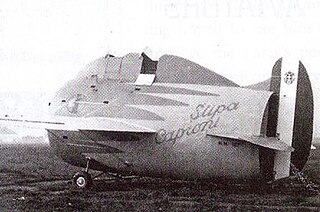| Caproni Ca.13 | |
|---|---|
 | |
| Milano I | |
| Role | Experimental aircraft |
| Manufacturer | Caproni |
| First flight | 1912 June 11 |
| Status | Retired |
| Number built | 1 |
The Caproni Ca.13 was a two-seater single-engine monoplane built by Caproni in the early 1910s.
| Caproni Ca.13 | |
|---|---|
 | |
| Milano I | |
| Role | Experimental aircraft |
| Manufacturer | Caproni |
| First flight | 1912 June 11 |
| Status | Retired |
| Number built | 1 |
The Caproni Ca.13 was a two-seater single-engine monoplane built by Caproni in the early 1910s.
The Ca.13 was a modern high wing monoplane with a wooden structure and canvas covering, equipped with a wing warping system to control roll and reinforced by metal tie rods connected to the fuselage and to a special structure placed above it; the fuselage was based on a wooden lattice structure, in turn reinforced by metal cables, and was covered in cloth only for the front half; the same wooden structure with a canvas covering characterized the empennages. The fixed undercarriage was composed of two front wheels with anti-overblank pads and another smaller, tailed shoe.
The Ca.13, like the Ca.12 from which it was directly derived, was a two-seater with the two cockpits arranged "in tandem" (ie one behind the other); the engine was an Anzani radial capable of developing a power of 70 hp. The Ca.13 differed from the immediate predecessor for the different curvature of the wings and for the different ratios between the areas of the front and rear surfaces. [1]
The Ca.13 was a two-seater designed for training and experimental military applications. It flew for the first time around the middle of 1912 (probably on 11 June) and soon showed excellent characteristics especially in terms of speed, reaching 129,900 km / h during a test flight.
Meanwhile, on May 20, Caproni had made arrangements with the Italian Aviation Society (S.I.A.) for the supply of a Caproni Ca.13 so that it, in turn, could offer it to the Royal Army. Thanks to this economic agreement, Caproni (which was in financial straits) could get a 70-80 hp Anzani, a particularly powerful and expensive engine. However, when he learned of an international aviation competition to be held in Vienna, he asked and obtained to postpone the delivery of the aircraft to the Holy See. in order to allow the new aircraft to participate in the competition; as a driver Enrico Cobioni was chosen, who had already distinguished himself by beating a series of national and world records with the previous Caproni models.
When they arrived at Aspern, near Vienna, in the second half of June, Ca.13 and his pilot gave good proof especially as regards speed; however, on 27 June, towards the end of the Wiener Neustadt-Aspern race, the engine went down and Cobioni, who was also among the first at the head of the race, was forced to make a lucky landing; there were no consequences, but the race ended for the Caproni team with nothing done.
At the same time, in Vizzola Ticino, another example of Ca.13 was prepared to satisfy the request of S.I.A. The plane was ready for testing on 12 July 1912 and, on that date, a sort of party was held at the Caproni workshops, a public celebration for the delivery of the new aircraft to which a crowd of curious, journalists, sportsmen and military. The plane, called "Milano I" with the traditional naval ceremony of the breaking of a bottle, took off without problems either with only the Cobioni on board, or with a passenger in the rear passenger compartment. Even the lady who had baptized the aircraft, the marquise Diana Crespi, was flown by Cobioni. The altitude test was also successful; however, a few days later, while Ca.13 was subjected to a flight duration test, the engine broke in the same way as that of the plane brought to Vienna; both were then replaced, and the aircraft were equipped with 60 hp engines.
Later, however, the order given by the Aviation Battalion Battalion of the Air Force Service to train all military pilots in military schools (which greatly reduced the activity of the Caproni civil school) and the removal of Cobioni (which, returning to Switzerland in search of more substantial earnings, deprived Caproni of his most experienced pilot and the only pilot who had piloted aircraft with power greater than 35 hp) made sure that the activity of the Caproni company was reduced a lot; the situation remained stagnant for the rest of the summer of 1912.

Data from Aeroplani Caproni – Gianni Caproni ideatore e costruttore di ali italiane [2]
General characteristics
Performance

Caproni, also known as Società de Agostini e Caproni and Società Caproni e Comitti, was an Italian aircraft manufacturer. Its main base of operations was at Taliedo, near Linate Airport, on the outskirts of Milan.

The Caproni Ca.60 Transaereo, often referred to as the Noviplano (nine-wing) or Capronissimo, was the prototype of a large nine-wing flying boat intended to become a 100-passenger transatlantic airliner. It featured eight engines and three sets of triple wings.

The Caproni Ca.1 was an experimental biplane built in Italy in 1910. It was the first aircraft to be designed and built by aviation pioneer Gianni Caproni, although he had previously collaborated with Henri Coandă on sailplane designs.

The Stipa-Caproni, also known as the Caproni Stipa, was an experimental Italian aircraft designed in 1932 by Luigi Stipa (1900–1992) and built by Caproni. It featured a hollow, barrel-shaped fuselage with the engine and propeller completely enclosed by the fuselage—in essence, the whole fuselage was a single ducted fan. Although the Regia Aeronautica was not interested in pursuing development of the Stipa-Caproni, its design influenced the development of jet propulsion.

The Gianni Caproni Museum of Aeronautics is Italy's oldest aviation museum, as well as the country's oldest corporate museum. It was established in 1927 as the Caproni Museum by Italian aviation pioneer and aeronautical engineer, Giovanni Battista "Gianni" Caproni and his wife, Timina Guasti Caproni.
The Caproni Ca.131 was a prototype for a large aircraft built in Italy in 1934, intended for use as either a bomber or airliner. It was a conventional low-wing cantilever monoplane, powered by a radial engine on each wing and in the nose. The main undercarriage was housed within large streamlined spats. Configured as an airliner, it would have seated 17 passengers.

The Caproni Ca.87 was an Italian flying boat built in the 1920s for a planned transatlantic flight.

The Caproni Ca.16 was a single-engine monoplane designed and built by Caproni in the early 1910s.
The Caproni Ca.10 was a single-engine monoplane designed and built by Caproni in the early 1910s.

The Caproni Ca.9 was a single-engine monoplane designed and built by Caproni in the early 1910s.

The Caproni Ca.6 was a single-engine biplane designed and built by Caproni in the early 1910s.

The Caproni Ca.7 was a proposed biplane designed by Caproni in the early 1910s.

The Caproni Ca.8 was a single-seat monoplane designed and built by Caproni in the early 1910s.

The Caproni Ca.22 was a single-engine monoplane made by the Italian company Aeronautica Caproni in 1913.
The Caproni Ca.25 was a single-engine monoplane made by the Italian company Aeronautica Caproni in 1914.

The Caproni Ca.11 was a single-engine monoplane designed and built by Caproni in the early 1910s.

The Caproni Ca.12 was a two-seater single-engine monoplane built by Caproni in the early 1910s.

The Caproni Ca.105 was a multirole high wing single engine monoplane developed by the Italian aeronautical company Aeronautica Caproni in the late 1920s.
The Caproni Ca.142 was a three-engined multirole aircraft built by Caproni in the mid-1930s.

The Caproni Ca.53 was an Italian prototype light bomber built in the last months of World War I.